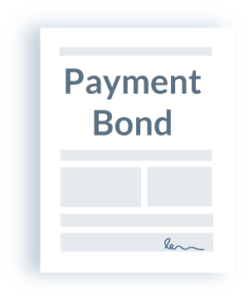
When working on a state or federal construction project, the payment bond is key. If you’re unpaid for labor or materials furnished to a state or federal construction project, you’re entitled to file a claim against the payment bond. This works exactly like a traditional mechanic’s lien claim, except that instead of filing your claim against the property itself, you’re filing a claim against the payment bond, which stands in place of the property.
The payment bond becomes the center of the universe when payment problems arise on public construction projects, and so it’s surprising how many project participants work on these projects without the payment bond in-hand.
Luckily, claimants are pretty much always entitled to a copy of the payment bond. But a claimant typically needs to request it, first.
 You’re entitled to a copy of the payment bond
You’re entitled to a copy of the payment bond
Remember this statement: You are entitled to a copy of the payment bond. No ifs, ands, or buts about it. On construction projects in nearly every state and county, if the project is a public work, the state laws provide that you must be provided a copy of the payment bond upon request. You’re usually allowed to request it from either the prime contractor or the public entity commissioning the work.
While some state statutes restrict who can request a copy of the payment bond, not all states offer such protection. Consider the statute in New York’s Little Miller Act, for example, which opens the payment bond for inspection to the public:
A copy of such payment bond shall be kept in the office of the head of the department or bureau having charge of the public improvement in connection with which the bond was given and a copy shall also be kept in the office of the comptroller or other appropriate official; such copies shall be open to public inspection.
Related Reading:
- Payment Bond Claims: How to get paid by a surety bond in construction
- Construction Payment Bonds – What Contractors Must Know
- Webinar: Nuts and Bolts of Miller Act Payment Bond Claims
How to get a copy of the payment bond
Now that you know you’re entitled to a copy of the payment bond, you may be wondering: How do I get it?
First and foremost, just ask for it!
Sharing information and maintaining open lines of communication at the seeds of a healthy construction project. But, unfortunately, things aren’t always that simple.
State project procedures
Each state has slightly different procedures for requesting a copy of payment bonds. But, generally, a formal written request to your customer, the GC, and/or the surety will do the trick. Keep in mind, though, a formal message doesn’t mean it has to be an adversarial one, especially when sent at the start of a job.
In most cases, written requests must be sent by certified mail or certified mail with return receipt requested. In a minority of cases, the requesting party must actually provide a notarized affidavit affirming that they are furnishing to the project. Be sure to check your state’s statute regarding the mailing requirements.
In states where preliminary notices are required on state construction projects, it’s a good practice to actually include this request within that notice. Whenever a preliminary notice is ordered from Levelset , we have that formal request for information built into the notice form. This ensures that the potential lien claimant gets a copy of the payment bond at the very start of construction.
Federal project procedure
If working on a federally funded project, there’s another option. You can always send a Freedom of Information Act request. Under these regulations, you have the right to request and access federal agency records or information. Obviously, with some exceptions and limitations. However, bonding information is not one of those exceptions.
For more, see: Getting a Copy of the Payment Bond |Freedom of Information Act
Why it’s important to get a copy of the payment bond
There are two primary reasons why it’s important to have a copy of the payment bond on a state or county public works project:
- It identifies the bonding company for you; and
- It identifies the terms of the bond.
First, knowing who the bonding company is can be critical to making a timely bond claim. In many states, you’re required to deliver your bond claim to the bonding company within a certain period of time. It’s obvious that you can’t send the claim to this party if you don’t know who they are. If you wait to investigate the identity of a surety just before a bond claim deadline, when tempers may be a bit more uncontrolled because of payment problems at the project, you may be left with a tall order – which, unfortunately, can impact your ability to make a claim.
Second, getting a copy of the payment bond discloses to you the terms of that bond. Failing to comply with the terms of the bond can compromise your entire bond claim. Therefore, once you get a copy of the bond it’s important to review it and make note of your potential obligations under the bond.
I just yesterday posted an article about why the terms of a payment bond are important. In addition to my article, consider this great post at the Legal Construction Zone Blog operated by Jennifer Watt: Some Dos and Don’ts For Making A Claim Against A Surety Bond. Her Do #1: Read the Bond. Good advice.
 You’re entitled to a copy of the payment bond
You’re entitled to a copy of the payment bond
